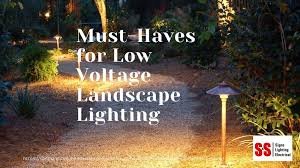
low voltage landscape lighting
Introduction to Low Voltage Landscape Lighting
When it comes to outdoor design, low voltage landscape lighting has become one of the most popular and practical solutions for homeowners, businesses, and public spaces. This lighting system operates at 12 volts rather than the standard 120 volts found in household electrical systems. The lower voltage not only reduces energy consumption but also enhances safety, making it a perfect choice for illuminating gardens, walkways, patios, and architectural features. By combining aesthetic appeal, energy efficiency, and versatility, low voltage lighting transforms outdoor spaces into welcoming environments that can be enjoyed day and night.
Understanding Low Voltage Lighting Systems
A low voltage lighting system consists of three main components: a transformer, fixtures, and wiring. The transformer reduces the electrical output from 120 volts to 12 volts. Fixtures, which can include spotlights, path lights, floodlights, and deck lights, are then connected through low-voltage cables. This setup allows for flexible designs and easy installation compared to traditional high-voltage systems. Because the system runs on lower voltage, homeowners have greater freedom in experimenting with light placement and design without the risks associated with higher electrical outputs.
Why Choose Low Voltage Lighting?
There are several compelling reasons to choose low voltage landscape lighting over other outdoor lighting systems:
- Energy Efficiency – Low voltage systems consume significantly less electricity, especially when combined with LED bulbs.
- Safety – With only 12 volts of power, the risk of electrical shock is greatly minimized, making it safer for DIY installation and family environments.
- Flexibility – Fixtures can be moved or added easily, allowing for evolving designs as landscapes change over time.
- Cost Savings – Lower energy usage results in reduced electricity bills, while the long life of LEDs minimizes replacement costs.
- Aesthetic Appeal – Low voltage lights offer a softer, more natural glow compared to harsh high-voltage options, enhancing the beauty of plants, architecture, and pathways.
Popular Applications of Low Voltage Lighting
Low voltage lighting can be adapted for numerous outdoor uses, each enhancing both safety and beauty:
- Pathway Lighting: Ensures safe navigation of driveways, walkways, and garden paths while adding charm.
- Accent Lighting: Highlights trees, statues, water features, and architectural details.
- Deck and Patio Lighting: Creates inviting spaces for evening gatherings and dining.
- Security Lighting: Provides strategic illumination around dark corners or entry points, deterring potential intruders.
- Garden Lighting: Enhances the natural textures and colors of flowers, shrubs, and landscaping.
By mixing these applications, homeowners can achieve a layered lighting effect that balances functionality with elegance.
Low Voltage vs. Line Voltage Lighting
A key question for homeowners is whether to choose low voltage lighting or traditional line voltage lighting. Line voltage operates at 120 volts and requires more complex installation, including conduit and junction boxes. It is often used for large-scale, commercial projects. Low voltage, by contrast, is easier to install, safer for residential use, and more energy-efficient. While line voltage can produce more intense illumination, low voltage provides sufficient brightness for most residential outdoor needs while offering greater design flexibility.
The Role of LED Technology
The rise of LED (light-emitting diode) technology has revolutionized low voltage landscape lighting. LEDs consume up to 80% less energy than incandescent bulbs and can last over 50,000 hours. This makes them ideal for outdoor environments where reliability and durability are crucial. LEDs also come in a range of color temperatures, from warm white to cool daylight, allowing homeowners to tailor the ambiance of their landscapes. The combination of low voltage systems and LED bulbs represents one of the most sustainable lighting solutions available today.
Design Principles for Effective Landscape Lighting
Good lighting design is both an art and a science. To maximize the impact of low voltage lighting, designers follow certain principles:
- Balance: Distribute light evenly across the landscape without creating dark voids or overly bright spots.
- Layering: Use a mix of uplighting, downlighting, and path lighting to create depth and dimension.
- Focal Points: Highlight key features such as a tree, sculpture, or water fountain.
- Shadow and Contrast: Incorporate shadows to add drama and texture rather than relying on uniform brightness.
- Functionality: Ensure pathways and stairs are well-lit for safety, without overwhelming surrounding areas.
By following these principles, low voltage lighting can transform even a modest yard into a visually captivating outdoor retreat.
Installation Process of Low Voltage Lighting
One of the reasons low voltage systems are popular is their relatively simple installation process. The steps generally include:
- Planning the Layout: Determine which areas need illumination and select appropriate fixtures.
- Installing the Transformer: Position the transformer near a power source and mount it securely.
- Laying the Cables: Run low-voltage cables along pathways, burying them slightly for protection.
- Connecting Fixtures: Attach lights to the cable using connectors, ensuring secure and waterproof seals.
- Testing and Adjusting: Power on the system, adjust angles, and ensure consistent brightness across all fixtures.
Many homeowners undertake this as a DIY project, though professional installation ensures precision, durability, and compliance with safety standards.
Maintenance of Low Voltage Lighting Systems
Maintaining low voltage lighting is straightforward but essential for long-term performance:
- Cleaning Fixtures: Remove dirt, leaves, and debris to maintain brightness.
- Checking Connections: Inspect cables and connectors for wear or corrosion.
- Replacing Bulbs: Swap out burnt-out bulbs promptly to maintain design integrity.
- Adjusting Fixtures: Realign lights as plants grow or landscaping changes.
Routine maintenance ensures the lighting system continues to deliver safety and aesthetic appeal for years.
Energy and Environmental Benefits
Low voltage landscape lighting is not only cost-effective but also environmentally friendly. The reduced energy consumption lowers carbon footprints, while the long lifespan of LED bulbs decreases waste from frequent replacements. For eco-conscious homeowners, low voltage systems are an attractive way to beautify outdoor spaces without compromising sustainability.
Cost Considerations
The cost of installing low voltage landscape lighting varies depending on design complexity, fixture quality, and installation method. DIY installations are more affordable, while professional designs may require a larger investment. However, the long-term savings on energy and maintenance often offset initial expenses. Many homeowners view it as a worthwhile investment that enhances property value, curb appeal, and safety simultaneously.
Where to Buy Low Voltage Landscape Lighting
Low voltage lighting systems and accessories are widely available at home improvement stores, specialized lighting shops, and online retailers. For inspiration and product selection, homeowners can explore the Lowe’s outdoor lighting section. Another trusted option is the Home Depot landscape lighting collection, which offers a wide range of fixtures, transformers, and cables suitable for various budgets and design preferences. These platforms provide not only products but also guides, reviews, and ideas for successful installations.
Future of Low Voltage Landscape Lighting
The future of outdoor lighting lies in smart technology integration. Low voltage systems are increasingly being paired with Wi-Fi or Bluetooth controls, allowing homeowners to adjust brightness, colors, and schedules through mobile apps or voice assistants. Solar-powered low voltage options are also on the rise, combining renewable energy with efficient LED technology. As design trends evolve, the focus will remain on sustainability, customization, and convenience.
Conclusion
Low voltage landscape lighting is more than just an outdoor accessory; it is a blend of functionality, safety, and artistry. By operating on a 12-volt system, it offers unmatched safety, energy efficiency, and design flexibility compared to traditional lighting methods. Whether highlighting a majestic tree, guiding visitors along a pathway, or creating a warm atmosphere for evening gatherings, low voltage lighting elevates the beauty and usability of outdoor spaces. With the ongoing advancements in LED and smart technology, this lighting solution will continue to shape the way homeowners and designers bring life to landscapes after sunset.






